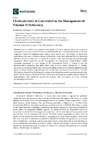Identificador persistente para citar o vincular este elemento:
https://accedacris.ulpgc.es/handle/10553/73256
| Campo DC | Valor | idioma |
|---|---|---|
| dc.contributor.author | Sosa Henríquez, Manuel José | en_US |
| dc.contributor.author | Gómez de Tejada Romero, M. Jesús | en_US |
| dc.date.accessioned | 2020-06-15T08:00:13Z | - |
| dc.date.available | 2020-06-15T08:00:13Z | - |
| dc.date.issued | 2020 | en_US |
| dc.identifier.issn | 2072-6643 | en_US |
| dc.identifier.other | Scopus | - |
| dc.identifier.uri | https://accedacris.ulpgc.es/handle/10553/73256 | - |
| dc.description.abstract | Vitamin D deficiency is a global health problem due to its high prevalence and its negative consequences on musculoskeletal and extra-skeletal health. In our comparative review of the two exogenous vitamin D supplementation options most used in our care setting, we found that cholecalciferol has more scientific evidence with positive results than calcifediol in musculoskeletal diseases and that it is the form of vitamin D of choice in the most accepted and internationally recognized clinical guidelines on the management of osteoporosis. Cholecalciferol, unlike calcifediol, guarantees an exact dosage in IU (International Units) of vitamin D and has pharmacokinetic properties that allow either daily or even weekly, fortnightly, or monthly administration in its equivalent doses, which can facilitate adherence to treatment. Regardless of the pattern of administration, cholecalciferol may be more likely to achieve serum levels of 25(OH)D (25-hydroxy-vitamin D) of 30-50 ng/mL, an interval considered optimal for maximum benefit at the lowest risk. In summary, the form of vitamin D of choice for exogenous supplementation should be cholecalciferol, with calcifediol reserved for patients with liver failure or severe intestinal malabsorption syndromes. | en_US |
| dc.language | eng | en_US |
| dc.relation.ispartof | Nutrients | en_US |
| dc.source | Nutrients [EISSN 2072-6643], v. 12 (6), (Mayo 2020) | en_US |
| dc.subject | 3206 Ciencias de la nutrición | en_US |
| dc.subject.other | Calcifediol | en_US |
| dc.subject.other | Cholecalciferol | en_US |
| dc.subject.other | Hypovitaminosis D | en_US |
| dc.subject.other | Vitamin D | en_US |
| dc.title | Cholecalciferol or Calcifediol in the Management of Vitamin D Deficiency | en_US |
| dc.type | info:eu-repo/semantics/review | en_US |
| dc.type | Article | en_US |
| dc.identifier.doi | 10.3390/nu12061617 | - |
| dc.identifier.scopus | 85085909431 | - |
| dc.contributor.authorscopusid | 7004134221 | - |
| dc.contributor.authorscopusid | 6603384374 | - |
| dc.identifier.eissn | 2072-6643 | - |
| dc.identifier.issue | 6 | - |
| dc.relation.volume | 12 | en_US |
| dc.investigacion | Ciencias de la Salud | en_US |
| dc.type2 | Reseña | en_US |
| dc.utils.revision | Sí | en_US |
| dc.date.coverdate | Mayo 2020 | en_US |
| dc.identifier.ulpgc | Sí | es |
| dc.description.sjr | 1,418 | |
| dc.description.jcr | 5,717 | |
| dc.description.sjrq | Q1 | |
| dc.description.jcrq | Q1 | |
| dc.description.scie | SCIE | |
| item.fulltext | Con texto completo | - |
| item.grantfulltext | open | - |
| crisitem.author.dept | GIR SIANI: Ingeniería biomédica aplicada a estimulación neural y sensorial | - |
| crisitem.author.dept | IU Sistemas Inteligentes y Aplicaciones Numéricas | - |
| crisitem.author.orcid | 0000-0001-6845-2933 | - |
| crisitem.author.parentorg | IU Sistemas Inteligentes y Aplicaciones Numéricas | - |
| crisitem.author.fullName | Sosa Henríquez,Manuel José | - |
| Colección: | Reseña | |
Citas SCOPUSTM
18
actualizado el 08-jun-2025
Citas de WEB OF SCIENCETM
Citations
44
actualizado el 08-jun-2025
Visitas
210
actualizado el 28-dic-2024
Descargas
188
actualizado el 28-dic-2024
Google ScholarTM
Verifica
Altmetric
Comparte
Exporta metadatos
Los elementos en ULPGC accedaCRIS están protegidos por derechos de autor con todos los derechos reservados, a menos que se indique lo contrario.
